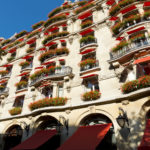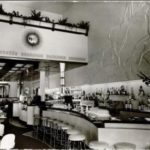Paris, France – 7 July 2013 – On 18 April 1913, the Excelsior wrote, “The Champs-Elysées and surrounding area will henceforth have another attraction for our elegant guests. The Plaza will be opening next Sunday and the magnificent hotel is known to be a microcosm of everything that most pleases our élite visitors – an incomparable location, apartments decorated in a tastefully delicate style and the most modern amenities. The Plaza’s delicious restaurant will be opening shortly and will undoubtedly enjoy the same success.”
Since then, the Plaza Athénée has remained one of the symbols of traditional French hospitality, fine dining and Parisian glamour, upholding the traditions of luxury hotels that are as timeless as they are contemporary.
100 years, Hôtel Plaza Athénée in Paris is looking ahead to the next century
In keeping with Dorchester Collection’s continuous investment in taking the luxury experience to new levels, the iconic hotel will undergo a partial restoration to integrate additional buildings creating six new guest rooms, eight suites, a ballroom and two event spaces.
Over the past several years, Hôtel Plaza Athénée has had the opportunity to purchase three buildings surrounding the hotel. These include a townhouse to the right of the hotel on 29 avenue Montaigne; a townhouse on rue Clément Marot; and the building where Le Relais Plaza is located.
Despite every effort to maintain the hotel’s activity during this period, François Delahaye, COO of Dorchester Collection and general manager of Hôtel Plaza Athénée, has resolved to close the hotel to preserve the guests’ comfort and convenience whilst the developments take place, commencing on 1 October 2013. In May 2014, Hôtel Plaza Athénée guests will rediscover the warm, refined surroundings of the hotel ready to embrace its next century.
The subtle restoration will revitalise the hotel and will be carried out with the utmost sensitivity; great care will be taken to retain the charm and quintessentially Parisian character of the hotel.
Now, in addition to a visual emphasis on the past 100 years and the surprises planned throughout the year at the hotel (for example the provision of facsimile newspapers dating from that time), the Plaza Athénée is organising a few major events to celebrate this unique anniversary – and pave the way for the next 100 years!
100 years of conviviality and fine dining
After a traditional Epiphany cake with its trinket in the form of a key, opening the door to a year of festivities, the Plaza Athénée has a number of invitations for its guests:
– In January, they can taste the new cocktail, “Baccarat Harcourt”, at the Bar du Plaza Athénée. Its main feature is its intense red colour, the famous “Baccarat Red Gold” that symbolises the crystal manufacturer and the Plaza Athénée where the cocktail is reflected in the patterns on the crystal glasses. This delicious drink will be premiered from 18 to 22 January 2013 at the VIP Club bar for the Maison et Objet (House & Object) exhibition.
– On 21, 22 and 23 February: taking a whimsical look back at the hotel’s origins and the German background of founder, Emile Armbruster, Werner Kuchler, the iconic restaurant manager who is celebrating 41 years of service at the hotel this year, has organised 3 Bavarian evenings. In June, he will take us on the most glamorous of historic cruises when the Relais Plaza becomes a replica of the dining room on board the famous French ocean liner, Normandie!
– On Saturday 20 April, to commemorate the opening of the hotel, a delightful surprise will await clients in the Courtyard Garden where over one hundred brightly coloured balloons will be released and guests will be able to share in a gigantic “anniversary” cake!
– Finally, from 1 February and throughout the year, all the hotel’s restaurants will celebrate the event by turning the spotlight on a dish specially created for the occasion. Guests in Alain Ducasse’ restaurant, for example, can order a Hot Truffle and Guinea Fowl Pâté. At the Relais Plaza, there will be Calf’s Head with Spicy Tomato Sauce and Macaire Potatoes. At breakfast time, there will be Poached Eggs Cardinal. In the Galerie des Gobelins, guests will be able to savour a Melba with Seasonal Fruit designed by Christophe Michalak.
100 years of history, innovation and the sharing of knowledge
The Plaza Athénée is loyal to, and proud of, the values that have carried it through the decades without ever betraying its heritage and its love of innovation. This is why it wanted to give clients something to remember by cooperating with just two of the very fine companies with which it shares a piece of history.
– No less than 100 trees purchased by the Plaza Athénée will be planted in the grounds of the Palace of Versailles in early spring 2013.
– Next, the Plaza Athénée has worked with the Théâtre des Champs-Elysées to offer its clients an opportunity to be among the privileged few at one of the performances of “The Rite of Spring” given to mark the centenary of the Theatre itself, on 30 and 31 May, 6 and 7 June and, lastly, 25 and 26 June.
Moreover, as a reminder of this partnership and the history that binds the hotel and the theatre, a Morris column decorated with posters of the time will be set up in the hotel’s Courtyard Garden.
– The hotel’s most loyal clients will receive a card made of precious metal produced in a very limited edition. They will then be the sole owners of this “pass of the century” and no more will ever be produced again.
– Finally, the 100th anniversary will also give the Plaza Athénée an opportunity to create a time capsule containing references to its history and heritage. A box in the hotel’s emblematic colours will contain items dating from 1913 and contemporary items that are representative of the hotel, so that they are passed down for posterity. What are these items? Only the Plaza Athénée’s most loyal “fans” will be allowed to submit ideas!
Some “cardex” of famous clients
1913: The founding of a luxury hotel
In 1867, the Grand Hôtel de l’Athénée was opened in Rue Scribe by the famous Parisian banker, Louis Raphaël Bischoffsheim, to provide accommodation for guests at the Athénée Theatre.
In 1911, at a time when all the luxury hotels were beginning to flourish, Jules Cadillat decided to set up the Hôtel Plaza on Avenue Montaigne which, at that time, was lined with a number of private mansions and cabarets. Just a short walk from the Théâtre des Champs Elysées, this was a fashionable location, the place to be.
In 1913, the Théâtre des Champs-Elysées and the Hôtel Plaza prepared to open on 31 March and 1 April respectively. However, since the “Plaza” name had not been registered, a competitor attacked the Hôtel Plaza company on grounds of similarities between the names. The opening was delayed as a result, even though everything was ready e.g. embroidered linen, engraved tableware, writing paper with the Plaza monogram etc.
Emile Armbruster, the Managing Director at that time, then had an idea – he would add the name “Athénée”. It was the name of the hotel that he had managed previously but it had recently closed and the name “Athénée” was therefore available for use. By combining it with the name “Plaza”, the hotel was able to open its doors on 20 April – and avoid a lawsuit.
As far as accommodation at that time was concerned, the hotel had 19 rooms or apartments on each floor except the sixth, which was reserved for families.
Jules Cadillat wanted only the very best for the restaurant so he contacted chef Jacques-Léon Colombier, who had already won the “London Gourmet Prize” launched by chef Auguste Escoffier.
Designed as a place in which to spend the remainder of the evening after a show, it naturally became the haunt of the great masters of music, composers and performers.
The First World War and the 1920s
During the war, when numerous hotels were turned into hospitals, the Plaza Athénée was fortunate to remain as a hotel and it never closed, despite its recent inauguration and extension work.
The post-war years and 1920s marked the beginning of the Roaring Twenties. Paris became a major centre of attention. History, politics, industry and art attracted an international clientele.
The hotel’s area was doubled by the building of spacious apartments, a Courtyard Garden and the Régence and Marie-Antoinette Lounges, designed by architect Jules Lebfevre. The hotel stretched from 21 Avenue Montaigne to 27 Avenue Montaigne.
The 30s – a new start
In October 1929, the Wall Street crash devastated the hotel industry.
In 1934, after the temporary closure of the hotel, La Séquanaise insurance company bought the property but not the goodwill. The “Hôtel Plaza Athénée” name was put up for auction and purchased by François Dupré who then took over the management again. He reopened the hotel in 1936. The rooms on the 7th floor were turned into studio apartments rented on a monthly basis. They had communicating doors, which meant that the accommodation could be extended to cater for clients’ requirements.
That same year, Le Relais Plaza, the restaurant designed by architect and interior designer Constant Lefranc, opened its doors.
In 1939, the Plaza Athénée was requisitioned by the occupying forces. The staff secretly took its wine, linen, tapestries and silverware to a safe place, a private house in Rue Quentin-Bauchart.
René Lambert, who was appointed Managing Director of the hotel by François Dupré on 1 January 1939, having begun his career there as Head Receptionist, was removed from his position. He did not take over the reins again until the Liberation, when the Relais Plaza became the Americans’ cafeteria! Reflecting the contemporary preference for light meals that could be served quickly instead of the old, heavy lunches, René Lambert turned Le Relais into a snack bar, serving champagne by the glass and beer on tap.
The thirty glorious years
In 1947, Christian Dior moved to Avenue Montaigne to be close to the Plaza Athénée. A new era began. The clientele changed. Avenue Montaigne became an avenue of Haute Couture and the Plaza Athénée a luxury hotel for fashion and art. From Grace Kelly to Gary Cooper, and from Jackie Kennedy to the Ford family, the Plaza Athénée became an essential benchmark!
In 1963, Georges Marin took up the post of Director of the hotel after directing the Hôtel Royal in Evian and the Dorchester in London. He decided to undertake a major programme of renovations, realising that the hotel had to be continuously and constantly upgraded.
1968: The coup d’Etat
The events that occurred in Paris in May 1968 made the city look unattractive and unsafe. The Forte Group took advantage of the situation and took over the Plaza Athénée, which then became one of its “Exclusive Hotels”, under Director David Karr. However the Head Concierge Paul Bougenaux led the Plaza Athénée’s employees in a demonstration, in their hotel uniforms, on Avenue Montaigne to protest against the threatened sale of the hotel to a British group! After numerous ups and downs, Paul Bougenaux, the former Head Concierge, became Managing Director at the end of 1969, appointed by the Forte Group. His work would make the Plaza Athénée a Grand Hotel.
In 1979, the Management changed again. Having started in the Accounts Department before becoming Director in charge of Catering then Deputy Director, the Sicilian Franco Cozzo was appointed Managing Director. He decided to redecorate the hotel. Throughout the year, the Plaza Athénée was given ephemeral decorations reflecting the events and festivities occurring in other countries all over the world.
1995 to 1999: a period of transition
In 1995, Hervé Houdré, formerly Under-Director of the Plaza Athénée New York and former Director of Le Crillon, became the hotel’s Managing Director. Competition was fierce at that time, notably because of the recent modernisation of the Ritz and the Bristol. What’s more, France was undergoing a real technological revolution.
Hervé Houdré took a long cool look at the hotel. He wanted perfect service throughout the year, without a break. He wanted innovation in the hotel’s structures. The air conditioning and information technology were totally redone and brought up to date. To improve the hotel’s image, there was a revolution in the restaurants. Le Régence, Le Relais Plaza, La Cour Jardin and La Galerie des Gobelins were renovated.
On 23 January 1996, the Granada Compass company purchased the Plaza Athénée, the Georges V and the Trémoille from the Forte Group.
In 1997, after Granada had controlled the Forte Group for a year, the Sultanate of Brunei purchased the goodwill for the Plaza Athénée.
Since 1999: The luxury hotel of the future
On 6 December 1999, François Delahaye became Managing Director with the aim of anticipating the future, controlling the hotel, generating profits and, most of all, motivating his staff. In his quest for excellence, he asked Alain Ducasse to join him and supervise the restaurants: he was awarded 3 stars in 2001.
In 2000, the Plaza Athénée was the first luxury hotel in Paris to obtain ISO 9001 certification, a quality and excellence standard that engaged the entire hotel in a commitment to provide quality on a daily basis.
In 2001, a British company specialising in the management of international luxury hotels took over the management of the Plaza Athénée on behalf of the Brunei Investment Agency. As a result, the hotel became part of the Dorchester Collection, formerly the Dorchester Group, which already included the Dorchester in London, the Meurice in Paris, the Beverly Hills in Los Angeles, the Principe di Savoia in Milan and, more recently, the Bel Air in Los Angeles and the Richemond in Geneva. In May of that year, the new Bar du Plaza Athénée decorated by Patrick Jouin was opened. It is the first trendy bar opens in a luxurious hotel.
In 2003, the Brunei Investment Agency purchased the hotel buildings and, that same year, Laurence Bloch became its Director. She had the bedrooms redecorated in a contemporary but elegant style without losing any of the hotel’s Parisian atmosphere. The Alain Ducasse restaurant at the Plaza Athénée was redecorated by Patrick Jouin.
In 2008, the Dior Institut opened its doors and 3 new apartments were created on the 3rd floor.
In 2010 the Plaza Athénée was the first hotel to be distinguished as a “living heritage company” for its know-how and excellence in the area of fine dining.
In 2011, it was one of the first to be given the official title of “palace” (luxury hotel).
Since then, it has continued to renew itself, through the ongoing search for innovation on which its reputation is based.
The Plaza Athénée in a few key dates:
April 1913: Opening of the “Hôtel Plaza Athénée” on 20 April. The name was a combination of the “Plaza” (located on Avenue Montaigne) and the “Athénée”, a hotel in Rue Scribe whose name was provided by Emile Armbruster.
1920s: The hotel doubled in size thanks to the construction of grand apartments, a Courtyard Garden and the Régence and Marie-Antoinette lounges designed by architect Jules Lefèvre. The hotel stretched from 21 Avenue Montaigne to 27 avenue Montaigne.
1936: François Dupré bought the name “Hotel Plaza Athénée” and reopened the hotel, which had been temporarily closed since 1934. Also in 1936, Le Relais Plaza, the restaurant designed by architect and interior designer Constant Lefranc, opened its doors.
1947: Dior looked for premises near a luxury hotel and opened his boutique on Avenue Montaigne, making it the Avenue of Fashion.
1968: The Forte Group purchased the Plaza Athénée and ran it until 1996.
1996: Granada took over the Forte Group which, among other things, owned the Georges V in Paris, and the Plaza Athénée in Paris and New York. Granada swiftly sold off the luxury hotels.
1997: The Sultanate of Brunei bought the Plaza Athénée and announced that major work would be undertaken to give it back its place as one of the world’s leading luxury hotels. The work lasted from April 1998 to March 2000, during which time the hotel remained open.
1999: François Delahaye was appointed Director General and Alain Ducasse joined the hotel to supervise its various restaurants.
2000: The hotel obtained ISO 9001 certification indicating a quality-based approach designed to formalise the procedures used by the various trades and give better control of malfunctions.
2001: Dorchester Collection announced that it would now be managing the Hôtel Plaza Athénée in Paris on behalf of the Brunei Investment Agency which manages the Sultanate’s assets. The Plaza Athénée’s Bar was totally redecorated by Patrick Jouin.
2003: The Sultan of Brunei purchased the hotel buildings.
2008: France’s first Dior Institut opened at the Plaza Athénée. Two new suites were created at 21 Avenue Montaigne.
2010: The Plaza Athénée was awarded “living heritage company” status during the second semester for its know-how and excellence in the area of fine dining.
2011: In May, at the very first session, the Plaza Athénée obtained official distinction as a “palace” (luxury hotel).
The Plaza Athénée today, in a few key figures (on 31 December 2012):
· 365 days of service
· 84 building trades
· 573 employees
· 257 spouses
· 616 children
i.e. a total of 1,446 people, in addition to 3,000 suppliers.
















